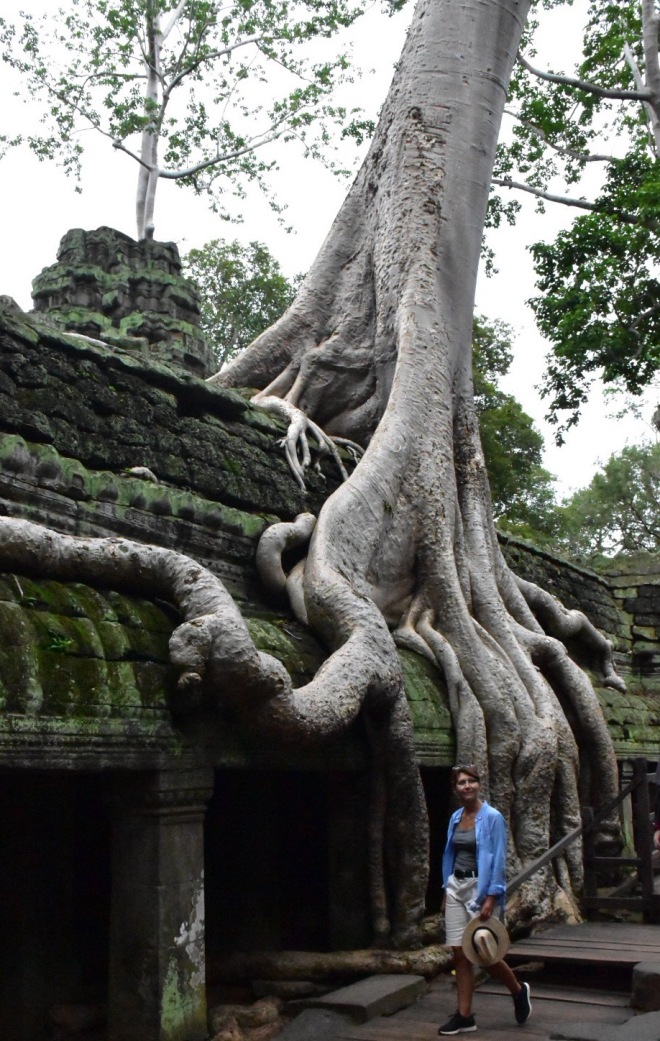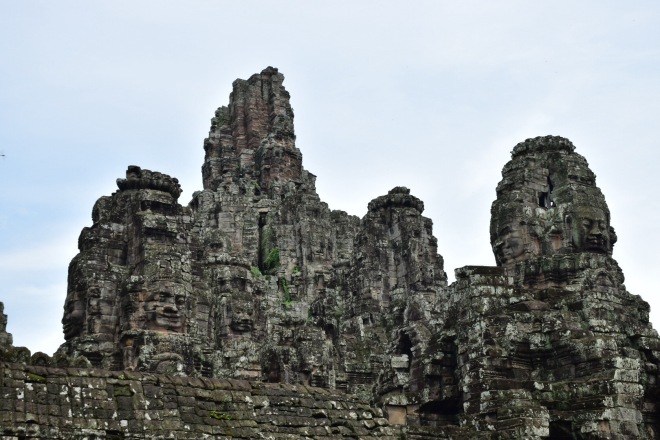
We’ve made our way to our second country, flying from Sai Gon to a quiet and modern airport in Siem Reap, Cambodia. First impressions were very positive, after the traffic mayhem of Vietnam, Cambodia feels calm & the Khmer people are so very warm & friendly. Although in use for a number of years now “Cambodia” doesn’t register as the name of the country with the local people who’ve experienced more name changes than most – they think of themselves as Khmer, & reference to Kampuchea is more likely to be acknowledged than ‘Cambodia’.
We will return to the Country’s troubled history in the next blog, but our first week was to focus on the Angkor Park area. Thanks to a great tip from our friend Jerry we hooked up with a local guide (Kheleur) a few weeks before we arrived. He set up 5 days of visits for us in the Angkor area, with a number of dawn starts. We haven’t had such an intense tourist schedule since we left home so we wisely slotted in a ‘rest day’ in the middle of the programme. As he was booked up Kheleur organised a guide, car & driver for us.
The week that followed was fabulous. It becomes apparent very quickly why Angkor Wat and the surrounding area is a Unesco World Heritage site that always crops up in the top 5 listings of “must see” places to visit in the world.

We don’t have the vocabulary to do anything like justice to the raw beauty of Angkor, it’s tempting to stop writing now & let lots of pictures do the talking. We will endeavour though, trying to point out our highlights & for what it’s worth our advice should you visit (you should – there is nowhere quite like this).

The first thing to say is that Angkor Wat itself is just one of a vast series of temples and if you want to experience the area it’s worth spending at least 2/3 days exploring – but the more you can manage, the better. A guide will enhance the experience enormously. You can hire a Tuk Tuk & use a map/guide, but you won’t get the rich detail a good guide can provide or see some of the less visited temples that are off the beaten track. Having travelled so far to see Angkor it’s worth shelling out a bit more as it’s likely to be a once in a lifetime experience that you will never forget. Our guide Buntheoun was wonderful company, his passion for Angkor, its history, and the Khmer people shone through, bringing to life the astonishing temples and the beautiful carvings that adorn them.

Angkor was the capital of the Khmer Empire from the 9th to 15th Centuries, becoming the largest city in the world in the 12th century. The scale of the buildings, their complexity and the carvings are reminiscent of the skills and ingenuity it must have taken to build the Pyramids.

What adds to the wild beauty of the temples is their co-existence with trees and jungle that at many sites are as much a feature as the buildings themselves. None more so than Ta Prohm (also known as the Tomb Raider Temple as this is where some of the film was shot) where giant trees have taken root & wrap themselves around the temples – it’s hard to tell if the trees are holding up the temples or vice-versa.

Despite the best efforts of conservation & restoration there are crumbling walls & large blocks of sandstone strewn about the sites, but this adds to the sense of unworldliness at Angkor, you really do feel that you’ve stepped back in time into a lost jungle empire.

Many of the carvings relate to Hindu folklore or Bhuddas, none more so than at Bayon one of the few sites where Bhuddist imagery hasn’t been removed in favour of Shiva, Vishnu & Brahma. Here we found dozens of Bhudda faces staring out at us benignly as the clouds opened & we enjoyed a rainy season downpour that eased the heat & humidity.

Bunthoeun guided us to sites off the tourist trail that we shared with just a handful of other gobsmacked visitors – so special.
We were up at 4.30 the next day to watch sunrise at Angkor Wat – far more company for this event but the temple is large & not overcrowded in rainy season. It’s tempting to focus on the lotus flower shaped towers at Angkor Wat, the archetypal image that has been replicated in the national flag. However, there is real treasure to be found in the gallery that runs around parts of the building, where intricate carvings depict images of life, heaven & hell. The quality and detail of a section completed in the 12th century is incredible. Many walked past these without giving them much of a glance. Happily for us Bunthoeun talked us through the galleries remarkable stories, that are still being told 800 years later – what a fitting tribute to the craftsmen and women who created them.
After a rest day we visited Banteay Srei, known as the Woman’s Temple that has beautiful decoration in sandstone. A few local people had mentioned this as their favourite in Angkor, in part due to the detail and depth of the decoration which are amazing

We then took a jungle trek into the hills to discover ancient Hindu carvings in streams and waterfalls. How these have survived erosion & remain so vivid is a mystery. As we trekked back down the hill we could hear gibbons calling to each other, a wonderful sound but no sighting.
Close to Siem Reap is Tonle Sap, the largest freshwater lake in S/E Asia. The lake supports a large proportion of the Country’s population, growing with the lake in rainy season. Our boat took us alongside the eerie flooded forests..

and the fishing villages built on stilts alongside the river. Although they looked ramshackle on first appearance, they are really quite substantial and built to survive what the weather throws at them. We briefly sailed into the main body of the lake which is so large you would think you are at sea – a bit intimidating.

On our last day we visited a Bhuddist monastery, another dawn start, and met one of its monks, spending time listening to his prayers and chants. Sitting quietly cross-legged with the monk should have been a time of deep reflection, maybe enlightenment. Instead we found our minds drifting to the increasingly excruciating pain in our knees, and in my case a growing horror that a bit of a dodgy tummy was about to announce itself in the most inappropriate way imaginable. No matter how serene the monk was, I don’t think he would have forgiven me that!
By way of complete contrast we finished the week at Siem Reap’s local market, where a wide variety of fruit, veg & other unusual delicacies are available. This included ants & ant eggs which became a necessary part of the diet during the starvation years of Khmer Rouge. Bunthoeun told us how these, along with many other foods which were eaten out of pure necessity, have become part of the regular diet of locals nowadays.

There was meat, OMG, so much meat & blood & guts & heads & limbs & beaks & claws & eyeballs & axes & cleavers & chopping – a stark reminder that behind the sanitised packaging of supermarkets there is still traditional butchery….here on graphic display in the market in front of two nervous veggies.
And so our week came to an end, fascinating, breathtaking and wonderful. This will be one of our trip highlights. Siem Reap really is a lovely city with such welcoming people. As you’ll have gathered from our gushing comments we can’t recommend Angkor highly enough. Although there is no direct flight from the UK, tying in a visit with a trip to Bangkok, Saigon or Hanoi (all direct flights) would be perfect.

In our next blog we reflect on a very different aspect of Cambodia’s past as we visit The Killing Fields in Phnom Penh and learn of the terror of the Khmer Rouge.




Angkor Wat is stunning isn’t it. Agree most visitors don’t understand the size of the complex. There are some detailed historical novels on the lives of the rulers and citizens you may want to read on your return. They explain the different invasions in the area and locals hiding in the jungle, and this is back when the complex was being built!
LikeLike
Thanks Julia!
LikeLike
I seem to remember a tv documentary saying that at its peak, Angkor was probably the biggest city on Earth. Photos from satellite show 60 miles of canals . . . . . sigh. One day . . . . . .
LikeLike
Great read and photos. I feel you should have tried the ants at least!
LikeLike
They have fried crickets as well Simon, which are crispy – quite fancied those!
LikeLike
I visited Siem Reap and Ankgor a few years ago with my daughter my very favorite place. I’m very excited to be going back there this oct with hubby. It is awesome. Loving your blog xxx thanks again for sharing
LikeLike
I visited Siem Reap and Angkor a few years ago with my daughter my very favorite place. I’m very excited to be going back there this oct with hubby. It is awesome. Loving your blog xxx thanks again for sharing
LikeLike
Thanks! Have a great return visit – it’s so good!!!!
LikeLike
Thanks for so many thoughts! Preparing a visit early next year.
LikeLike
Thanks! It’s an unforgettable experience & Siem Reap is lovely. Let us know if you want us to recommend a guide. Ours was excellent.
LikeLike
See my reflections from the recent trip to Sri Lanka
LikeLike
Thanks – love Sri Lanka!
LikeLike